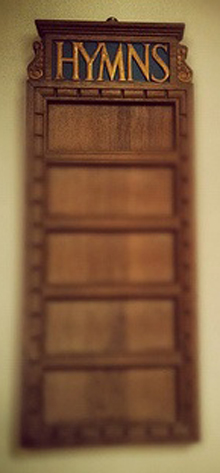Encouraging Hymn Knowledge to Create Community
 One of my great grandmothers enjoyed playing piano. She collected sheet music and had her favorites bound into books. I have her volumes dating back into the late 1800s. None of the tunes that she found worth preserving are played on the radio today.
One of my great grandmothers enjoyed playing piano. She collected sheet music and had her favorites bound into books. I have her volumes dating back into the late 1800s. None of the tunes that she found worth preserving are played on the radio today.
On the other hand, the Church is one place in our society where songs of past centuries are regularly revived. Only the words remain to the music of Bible times. The advent of a universal system of notation in the ninth century gave music—both melody and lyric—longevity. Today’s Christians sing songs that span from the Gregorian chant to the current folk and rock genres.
I attended a concert of a contemporary rock-style band recently where the tune to Of the Father’s Love Begotten from the 13th century was used as a motif.
The treasure and legacy of Christian music is most appreciated during the Christian season when even today’s pop singers make albums of music written hundreds of years ago. People who never attend church sing along with car radio (at least to the first verse).
Church music spans other seasons that are less recognized by secular culture but are a treasure of the church. Much of today’s hymnody comes from the Protestant tradition where pastors often wrote songs as a preaching tool. Martin Luther, Isaac Watts and the Wesleys were preachers and hymn writers whose work is still sung in churches around the world.
The legacy of praising God in song continues with a wealth of new music heard by many for the first time on Christian radio.
Often, hymns are a collaboration between the poet and the tune crafter—not unlike the great teams which brought us operettas and musicals. In fact, Sullivan, of Gilbert and Sullivan, wrote the tune of Onward Christian Soldier.
Knowing something about the hymns we sing adds to their meaning.
In the 1600s, Martin Rinkart was a village pastor in Germany during the years of the Great Plague. He buried as many as 50 of his parishioners a day, 4000 a year, including his wife. One of the most enduring hymns of thanksgiving came from his pen — Now Thank We All Our God.
In the 1700s, John Newton repented his life as a slave trader and wrote a perennial favorite used in both religious and secular settings — Amazing Grace. Another prolific hymn writer, Isaac Watts, broke with the tradition of sticking to the biblical Psalms as text. When I Survey the Wondrous Cross is the best known of his hundreds of hymns—some of them written specifically for children.
Some great hymns have come from the recognized masters such as Handel, Bach, and Beethoven.
Women, following the biblical tradition of Miriam, gained notice as hymn writers in the 1800s and early 1900s. They included the blind Fanny Crosby (Blessed Assurance) and Katherine Lee Bates (America, the Beautiful).
The difficult process of publishing and printing helped preserve hymns. Prior to 1980, it took about 40 years to compile and publish a hymnal within a denomination, which slowed the adoption of current music but added life to the existing hymns. Today’s publishing allows instantaneous publication and it remains to be seen how that will affect the legacy of hymnody.
Despite the wealth of tradition, many congregations stick to the tried and true. One pastor complained that the congregation he served was content to sing the same 12 hymns over and over.
Later posts will address ways to both preserve and build upon hymn legacy and the way hymn knowledge and tradition impacts faith and Christian community.
